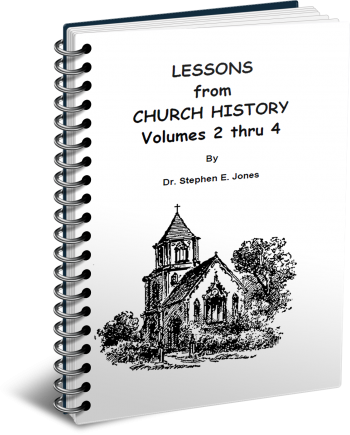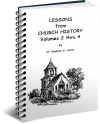Latest Posts
View the latest posts in an easy-to-read list format, with filtering options.

Volumes 2-4. This is the history of the Church from the Roman War (66-73 A.D.) to Constantine and the Council of Nicea in 325 A.D. with lessons to be learned from it.
Category - History and Prophecy

Jerusalem fell 40 years after the death/rejection of John the Baptist. Masada fell 40 years after the death/rejection of Jesus. Josephus goes out of his way to tell us of signs that occurred prior to the great disaster, which should have alerted the people of Judea to the reality of the situation. Most people treat these signs as coming from the minds of superstitious men of the day, or consider them to be propaganda designed by Josephus to justify Rome.
But there was one incident that is more historical in nature and cannot be ignored. Eusebius quotes Josephus in Eccl. Hist., III, 8,
“An incident more alarming still had occurred four years before the war [62 A.D.?], at a time of exceptional peace and prosperity for the city. One Jesus son of Ananias, a very ordinary yokel, came to the feast at which every Jew is expected to set up a tabernacle for God [Feast of Tabernacles]. As he stood in the Temple, he suddenly began to shout: ‘A voice from the east, a voice from the west, a voice from the four winds, a voice against Jerusalem and the Sanctuary, a voice against bridegrooms and brides, a voice against the whole people!’
“Day and night he uttered the cry as he went through the streets. Some of the more prominent citizens, very annoyed at these ominous words, laid hold of the fellow and beat him savagely. Without saying a word in his own defence or for the private information of his persecutors, he persisted in shouting the same warning as before. The Jewish authorities, rightly concluding that some supernatural force was responsible for the man's behaviour, took him before the Roman procurator. There, though scourged till his flesh hung in ribbons, he neither begged for mercy nor shed a tear, but lowering his voice to the most mournful of tones answered every blow with: ‘WOE TO JERUSALEM’!”
Josephus says this incident occurred “four years before the war.” This could not have meant four years before the siege of Jerusalem in 70 A.D., for this would have placed it at the Feast of Tabernacles of 66 A.D., when the Judeans destroyed the 12th Legion of Cestius Gallus. That was not “a time of exceptional peace and prosperity for the city.” Thus, Josephus must have meant four years before the beginning of the revolt in 66 A.D., which would place it in 62 A.D., shortly after James had been stoned and martyred in the Temple.
This unknown prophet named “Jesus son of Ananias” was sent to Jerusalem shortly thereafter to prophesy its destruction. It seems ironic to me that God would raise up a prophet named Jesus to give the city warning of impending disaster shortly after the city's prime intercessor had been stoned.
This event must surely have been widely known in the city, and it is highly unlikely that the Christians remained unaware of it. The Christians, led then by Symeon, successor to James, must have remembered the words of Jesus Christ in Luke 21:20-24,
{Luke 21:20} 20 But when you see Jerusalem surrounded by armies, then recognize that her desolation is at hand . . . {Luke 21:24} 24 and they will fall by the edge of the sword, and will be led captive into all the nations; and Jerusalem will be trampled under foot by the Gentiles [ethnos, “nations”] until the times of the Gentiles be fulfilled.
Symeon, if you will recall, was the son of Clopas, who was Joseph's brother, making Symeon a cousin of Jesus. (See Eusebius, Eccl. Hist., III, xi.)
Because Jesus' prophecies are so specific in regard to Jerusalem, there are many skeptics who insist that the Gospels were written AFTER the fall of Jerusalem, with Matthew and Luke putting these words into Jesus' mouth as if He had said them earlier. This is part of the Jewish argument against the New Testament and against Matthew and Luke in particular, for they hope to absolve themselves of the charge of putting to death the Messiah and instead lay that charge against the Romans.
It is somewhat difficult to prove the dating for the Gospel of Matthew, but Luke quotes many of the same statements. We know that Luke was Paul's traveling companion and was part of that generation. His book of Acts is full of statements that support the fact that Levitical Priests offered up the great Sacrifice to God in the Person of Jesus Christ. In Acts 2:23 and 36 Peter affirms this in his Pentecostal sermon. He repeats this in Acts 3:15, 4:10 and 5:30.
Not once does the New Testament tell us that Romans crucified Jesus, for then would the Scriptures have been broken. The law prophesied that the Levites were called to perform all the sacrifices that were acceptable to God. Jewish interests would love to shift this responsibility to Romans in order to prove that Jesus did not truly fulfill the law. They know that if the Romans crucified Jesus, then Jesus was not the Sacrifice for sin, as the New Testament teaches.
The fall of Jerusalem ended the time of transition between the Old and New Covenants. In other words, during those 40 years of grace, God not only gave the Jews time to repent, but also gave the Christians time to ponder and pray about the changes that had occurred with the Sacrifice of Christ on the cross. As I showed in Book I, the Christians in Jerusalem continued to perform all the rituals of the Old Covenant in the temple until the war put an end to the sacrifices altogether.
For this reason Paul wrote the book of Hebrews. It was to give these believers an alternative once Jerusalem was destroyed. Some say that Hebrews must have been written some time after the destruction of Jerusalem. However, it seems clear to me that Paul wrote it some time before his death in 65 or 66 A.D. Long before the destruction of Jerusalem, Paul certainly had the revelation of the “better things” set forth in the Book of Hebrews. Yet this teaching was important to keep Christians from joining the revolt.
By the way, virtually all of the early Church fathers in the Greek-speaking world of The Seven Churches attributed the book of Hebrews to Paul. In the fifth century Jerome changed the accepted order of the New Testament books, putting Romans as the first epistle in order to exalt Rome, and putting Hebrews and James toward the rear in order to downgrade the importance of Jerusalem. Dr. Earnest Martin writes in Restoring the Original Bible, p. 9,
“Jerome also placed the Book of Hebrews from its 10th place position in the manuscripts within the fourteen epistles of Paul and put it at the back (into the least position) because of its ‘Jewish’ characteristics and because some western theologians questioned whether it was written by Paul.”
Dr. Bullinger’s The Companion Bible, says in Appendix 95,
“Our English Bibles follow the order as given in the Latin Vulgate. This order, therefore, depends on the arbitrary judgment of one man, Jerome (382-429). All theories based on this order rest on human authority, and are thus without any true foundation.”
Non-Christian Jews had a more difficult time coping with the change following the destruction of the temple and did not really get their feet back on the ground for over a century, when Judaism arose in a new form without a temple as its central feature.
It is tragic that many Christians today have been fooled first by Dispensationalism and then by Christian Zionism into thinking that God's plan is to re-establish a physical temple in the old Jerusalem, complete with Levitical priests and animal sacrifices, as the center of His coming Kingdom. They say that the “Age of Grace” is nearly over, and that the “Age of Law” is about to be re-established. By this, they mean animal sacrifices will again become not only acceptable but required by God in the age to come.
Such a view tramples on the blood of Jesus Christ, making the efficacy of His Sacrifice a temporary interlude between eras of animal sacrifice. All the other “better” things in the book of Hebrews are said to be temporary as well. In effect, this view reverses the definition of “better things,” making the Old Covenant better and the New Covenant worse. This is not Christianity. This is Judaism disguised as Christianity. It is a counterfeit, and it denies the blood of Christ.
The destruction of Jerusalem proved the book of Hebrews to be the correct view. Jerusalem's destruction discredited the Ebionite view as much as it did Judaism itself. The Ebionites believed that circumcision was necessary for all to enter into a covenant relationship with God (hence, for salvation itself). They also believed that Jesus was a mere man with a Christ calling and rejected the idea that He was the Yahweh of the Old Testament who had been incarnated as a man. Needless to say, the Ebionites rejected the Book of Hebrews totally.
Jerusalem's fall occurred on the same day (9th of Av) that it fell to the Babylonians in the days of Nebuchadnezzar. This was also the date of the fall of Bethar, the last stronghold of the Bar-Cochba revolt. Bethar fell on the 9th of Av in 135 A.D. We will cover this portion of history later in this book.
The 9th of Av disasters are well known among Jews, but they do not understand the reasons why God allowed them. It was as much a mystery in 70 and 135 A.D. as it was in 586 B.C., because in neither case did they believe or understand the laws of tribulation in Lev. 26 or Deut. 28. They did not believe the prophet Jeremiah, but threw him into a pit. Neither did they believe Jesus, but crucified Him.
The solution to this lack of understanding is not to blame the Romans, nor to justify the Jews, nor to set aside the New Covenant in favor of the Old. The solution is the same as in Jeremiah's day. “Repent, for the Kingdom of God is at hand.”
Throughout the Middle Ages, the solution was the same. In more recent years, certain Jews became impatient and decided to end their iron yoke captivity without repenting. The Zionist movement advocated a return to the land of Palestine without resolving the underlying problem that had caused their dispersion in the first place. Their desire was to inherit the Kingdom apart from having to repent and admit that Jesus was the Messiah after all.
But the solution to their dilemma was NOT for the Jews to conquer Palestine by immigration and by force and terrorism. Their conquest did not resolve the underlying problem that has already brought destruction upon the city twice. Nor will their early success prevent another disaster that will be worse than the earlier calamities. Hopefully, this book will point to the true solution so that a few, at least, will be found worthy to escape those trying days.